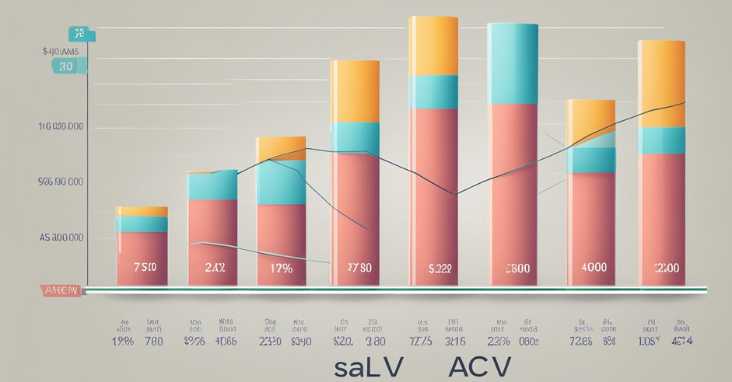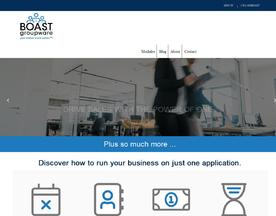What is ACV Sales? ACV Sales, or Annual Contract Value Sales, measure the average annual revenue from customer contracts, key for tracking long-term business value.
Annual Contract Value (ACV) has become a popular sales metric in recent years. It measures the annual revenue generated by a single customer contract, providing valuable insights into a company’s sales performance and customer acquisition strategy. ACV sales is particularly relevant for Software-as-a-Service (SaaS) businesses, where customer retention is crucial for long-term success.

Understanding ACV sales is essential for businesses looking to optimize their sales strategy. By analyzing ACV sales data, companies can identify which customer segments generate the most revenue and adjust their sales tactics accordingly. ACV sales can also be used to measure the effectiveness of customer acquisition efforts, as businesses can calculate the cost of acquiring a customer and compare it to the revenue generated over the lifetime of the contract.
Key Takeaways:
- ACV sales is a valuable sales metric that measures the annual revenue generated by a single customer contract.
- ACV sales is particularly relevant for SaaS businesses, where customer retention is crucial for long-term success.
- By analyzing ACV sales data, companies can optimize their sales strategy and measure the effectiveness of customer acquisition efforts.
Understanding ACV Sales
Definition and Importance
Annual Contract Value (ACV) is a metric used to measure the annual revenue generated by a customer’s subscription or contract. It is an important metric for businesses that offer subscription-based services or products. ACV sales helps businesses to understand the value of their customer relationships and to track the growth of their recurring revenue.
ACV sales is an important metric because it helps businesses to forecast their revenue and to identify opportunities for growth. By understanding their ACV sales, businesses can make informed decisions about their pricing strategy, customer acquisition, and retention efforts.
Calculating ACV Sales
To calculate ACV sales, businesses need to multiply the average monthly recurring revenue (MRR) by 12. For example, if a business has an average MRR of $1,000, then their ACV sales would be $12,000.
ACV sales can also be calculated by multiplying the average annual recurring revenue (ARR) by the percentage of the year that the customer has been subscribed. For example, if a customer has been subscribed for six months and their ARR is $10,000, then the ACV sales would be $5,000.
ACV vs ARR vs MRR
ACV, ARR, and MRR are all metrics used to measure recurring revenue, but they are calculated differently and serve different purposes.
ARR is the total annual revenue generated by a customer’s subscription or contract, regardless of when the revenue is recognized. MRR is the average monthly revenue generated by a customer’s subscription or contract. ACV sales is the annual revenue generated by a customer’s subscription or contract, calculated by multiplying the average MRR or ARR by 12.
While ARR and MRR are useful metrics for tracking revenue, ACV sales provides a more accurate picture of the value of a customer’s subscription or contract over the course of a year.
To learn more about ACV sales and its importance for businesses, check out this article.
ACV Sales Strategy
When it comes to maximizing revenue growth, ACV (Annual Contract Value) plays a crucial role in sales strategy. ACV is a measure of the average annual revenue generated by a single customer contract, and it helps sales teams to determine the value of each deal and prioritize their efforts accordingly.
Role in Revenue Growth
By focusing on high-ACV deals, sales teams can increase their revenue growth significantly. This is because high-ACV deals typically involve larger contracts and longer-term commitments, which generate more revenue over time. Additionally, high-ACV deals often require more complex sales efforts, which can lead to higher margins and greater profitability.
Influencing Pricing Strategy
ACV also plays a key role in influencing pricing strategy. By analyzing the ACV of past deals, sales teams can determine the optimal pricing for new deals and adjust their pricing strategies accordingly. This can help to maximize revenue and profitability while ensuring that pricing remains competitive.
Forecasting and Pipeline Management
ACV is also critical for forecasting and pipeline management. By tracking the ACV of each deal in the pipeline, sales teams can accurately predict future revenue and identify potential bottlenecks in the sales process. This can help to ensure that the pipeline remains healthy and that sales targets are met.
Overall, ACV is a powerful tool for sales strategy, revenue growth, pricing strategy, pipeline management, and sales efforts. By leveraging ACV effectively, sales teams can maximize their revenue potential and achieve long-term success.
Here is a great resource for more information on ACV and its importance in sales strategy.
ACV for SaaS Businesses
When it comes to SaaS businesses, understanding the Average Contract Value (ACV) is crucial. ACV represents the average revenue generated per customer, per year. It is a key metric that helps SaaS businesses understand their revenue streams and make informed decisions about their pricing strategies.
Subscription Models and ACV
SaaS businesses typically use subscription models to generate revenue. These models can be either monthly or yearly, and the ACV is calculated based on the revenue generated from these subscriptions. By understanding the ACV, SaaS businesses can determine the pricing structure that works best for their customers and their business.
Upsell and Cross-Sell Strategies
Upselling and cross-selling are two strategies that SaaS businesses use to increase their ACV. Upselling involves selling a higher-priced subscription to an existing customer, while cross-selling involves selling additional products or services to an existing customer. By using these strategies, SaaS businesses can increase their revenue per customer and improve their overall ACV.
Churn Rate and Customer Retention
Churn rate refers to the percentage of customers who cancel their subscriptions within a given period. High churn rates can negatively impact a SaaS business’s ACV. Therefore, it is crucial for SaaS businesses to focus on customer retention strategies to reduce churn rates. These strategies can include improving customer support, offering loyalty programs, and providing additional value to customers.
Overall, understanding the ACV is critical for SaaS businesses to make informed decisions about their pricing strategies and revenue streams. By focusing on subscription models, upselling and cross-selling strategies, and customer retention, SaaS businesses can improve their ACV and achieve long-term success.
For more information on ACV for SaaS businesses, check out this article.
ACV and Customer Acquisition

Customer acquisition is a crucial aspect of any business, and it directly impacts the ACV or average customer value. ACV is the average revenue generated by a single customer over their lifetime. In this section, we will explore the relationship between ACV and customer acquisition, and how businesses can optimize their customer acquisition strategy to increase ACV.
CAC and Its Impact on ACV
The customer acquisition cost (CAC) is the cost associated with acquiring a new customer. It includes all marketing and sales expenses, such as advertising, sales commissions, and salaries. CAC has a direct impact on ACV, as businesses need to acquire customers at a cost that is lower than the revenue generated by those customers.
To optimize ACV, businesses need to minimize their CAC by identifying the most effective marketing and sales channels. This requires a thorough analysis of customer behavior and preferences, as well as a deep understanding of the target market. By focusing on the most effective channels, businesses can acquire high-value customers at a lower cost, thereby increasing ACV.
Evaluating Customer Lifetime Value
Customer lifetime value (CLV) is the total revenue generated by a customer over their lifetime. It is a crucial metric for businesses, as it helps them evaluate the long-term profitability of their customer acquisition strategy. By increasing CLV, businesses can increase ACV, as customers who generate more revenue are more valuable.
To increase CLV, businesses need to focus on customer retention and loyalty. This requires a deep understanding of customer needs and preferences, as well as a commitment to providing exceptional customer service. By building strong relationships with customers, businesses can increase their CLV and ultimately their ACV.
High-Value Clients and ACV
High-value clients are customers who generate a significant amount of revenue for a business. They are crucial for increasing ACV, as they generate more revenue and are more likely to remain loyal to the business. To attract high-value clients, businesses need to focus on providing exceptional products and services, as well as a personalized customer experience.
By targeting high-value clients and providing exceptional customer service, businesses can increase their ACV and overall profitability. However, it is important to balance the cost of acquiring high-value clients with the revenue generated by those clients, to ensure a positive return on investment.
To learn more about optimizing customer acquisition and increasing ACV, check out this resource.
Metrics and Performance Analysis

ACV as a Sales Metric
ACV, or Annual Contract Value, is a crucial sales metric that measures the average annual value of a customer contract. It is an important metric for companies that offer subscription-based services or products. ACV is calculated by multiplying the average monthly recurring revenue (MRR) by 12 months. By tracking ACV, sales teams can determine the value of each customer and identify areas for growth.
KPIs and Sales Rep Performance
Key Performance Indicators (KPIs) are metrics that help sales teams measure their performance and progress towards their goals. Some common KPIs for sales teams include total revenue, revenue generated per sales rep, and customer acquisition cost. By tracking these metrics, sales teams can identify areas for improvement and adjust their strategies accordingly. Sales reps can also use KPIs to measure their individual performance and set goals for themselves.
Benchmarking with Pacific Crest Survey
The Pacific Crest Survey is an annual survey that collects data on key performance metrics for SaaS companies. The survey provides valuable insights into industry trends and benchmarks that companies can use to evaluate their own performance. By comparing their own metrics to those of top-performing companies in their industry, sales teams can identify areas for improvement and adjust their strategies accordingly.
To learn more about ACV and other sales metrics, check out this article from Salesforce.
Operationalizing ACV

Companies that sell subscription-based products and services use Annual Contract Value (ACV) as a key metric for measuring the value of their customer base. Operationalizing ACV involves integrating it with CRM systems, ensuring consistency and transparency in reporting, and managing ACV bookings and revenue recognition.
Integrating ACV with CRM Systems
Integrating ACV with CRM systems is crucial for accurate forecasting and tracking of customer value. By integrating ACV with customer data in CRM systems such as Salesforce or Hubspot, companies can track changes in ACV over time and use this data to make informed decisions about customer acquisition, retention, and expansion.
Consistency and Transparency in Reporting
To ensure consistency and total transparency in reporting, companies should establish clear guidelines for calculating ACV. These guidelines should include definitions of key terms, such as contract length and renewal rates, and specify how to calculate ACV for different types of contracts and pricing models.
ACV Bookings and Revenue Recognition
Managing ACV bookings and revenue recognition requires careful attention to detail and adherence to accounting standards. Companies should establish clear processes for recognizing revenue from subscription-based products and services, and ensure that these processes are consistently applied across all customer accounts.
To learn more about operationalizing ACV, check out this guide from Zuora, a leading provider of subscription management software.
Frequently Asked Questions

How is ACV calculated in a business context?
ACV (Annual Contract Value) is calculated by multiplying the average recurring revenue per customer by the number of customers in a given period. This metric helps businesses determine the total value of their customer base and forecast future revenue.
Can you provide an example of ACV sales in practice?
For example, a SaaS company with 1,000 customers paying an average of $1,000 per month would have an ACV of $12 million ($1,000 x 12 months x 1,000 customers).
What does ACV indicate in retail environments?
In retail environments, ACV (All Commodity Volume) is used to measure the total sales volume of a particular brand or product category across multiple stores or regions. It helps retailers understand the overall demand and market share of a product.
In marketing, how is ACV utilized to measure performance?
ACV is used in marketing to measure the value of a customer over time, which helps businesses determine the return on investment (ROI) of their marketing campaigns. By tracking changes in ACV over time, businesses can evaluate the effectiveness of their marketing efforts.
What is the significance of the ACV rate of sale?
The ACV rate of sale measures the speed at which a product or service is selling. It is calculated by dividing the total ACV of sales by the total number of days in a given period. This metric helps businesses determine the velocity of their sales and forecast future revenue.
How does ACV differ from ARR in financial reporting?
ACV is a forward-looking metric that measures the total value of a customer base, while ARR (Annual Recurring Revenue) measures the recurring revenue generated from existing customers in a given period. ACV takes into account the potential value of new customers, while ARR is based solely on existing customers.
To learn more about ACV and its applications in business, check out this helpful resource.















